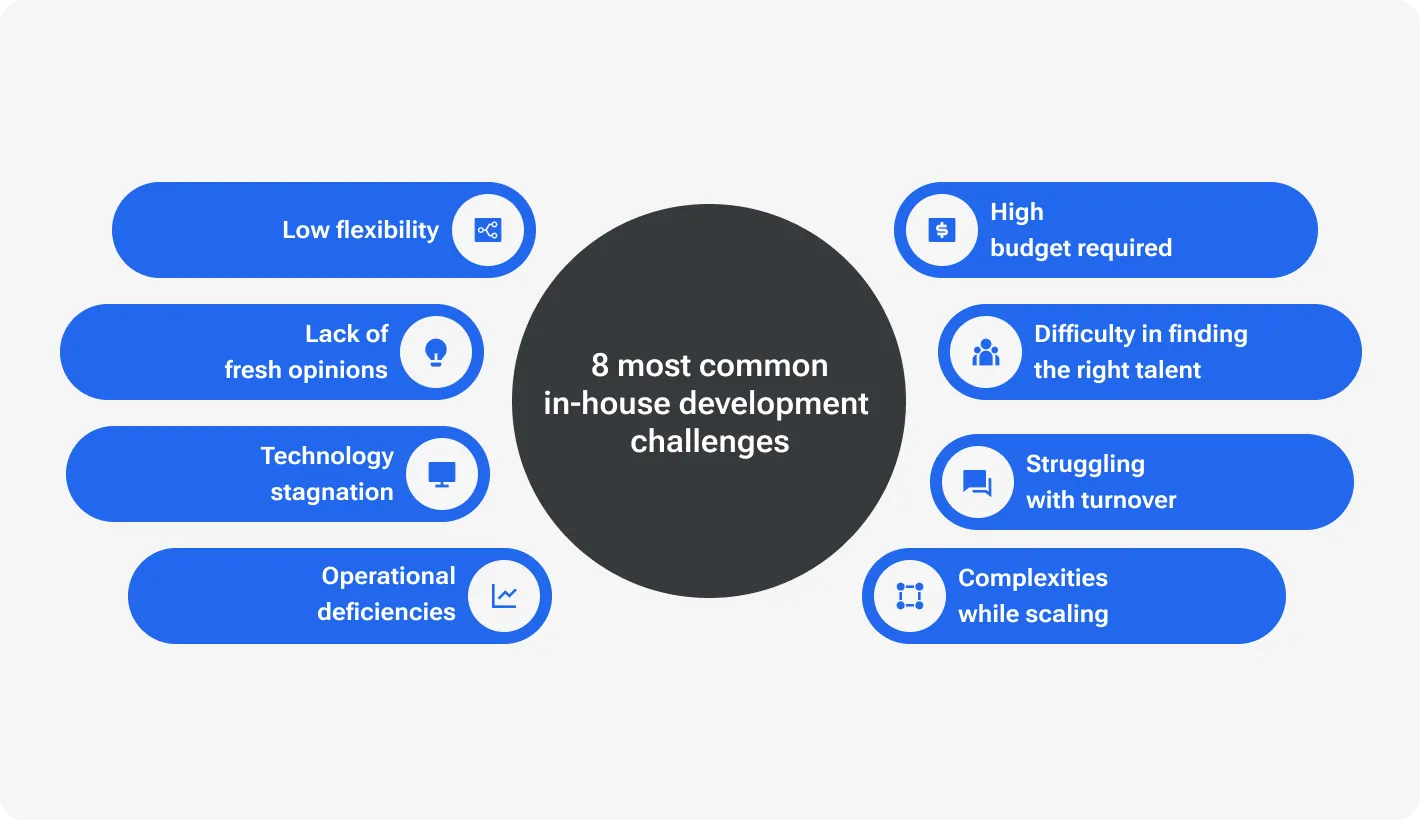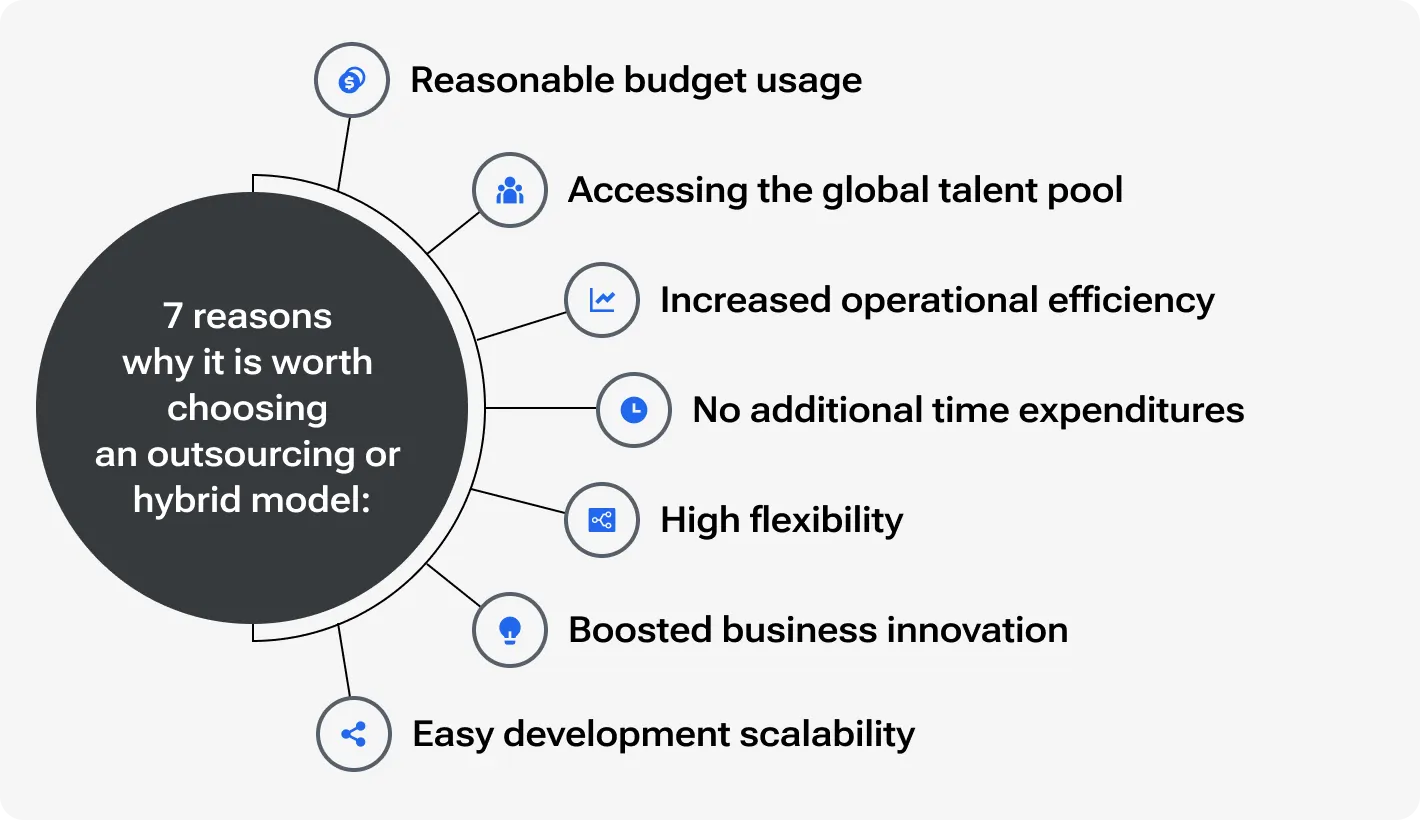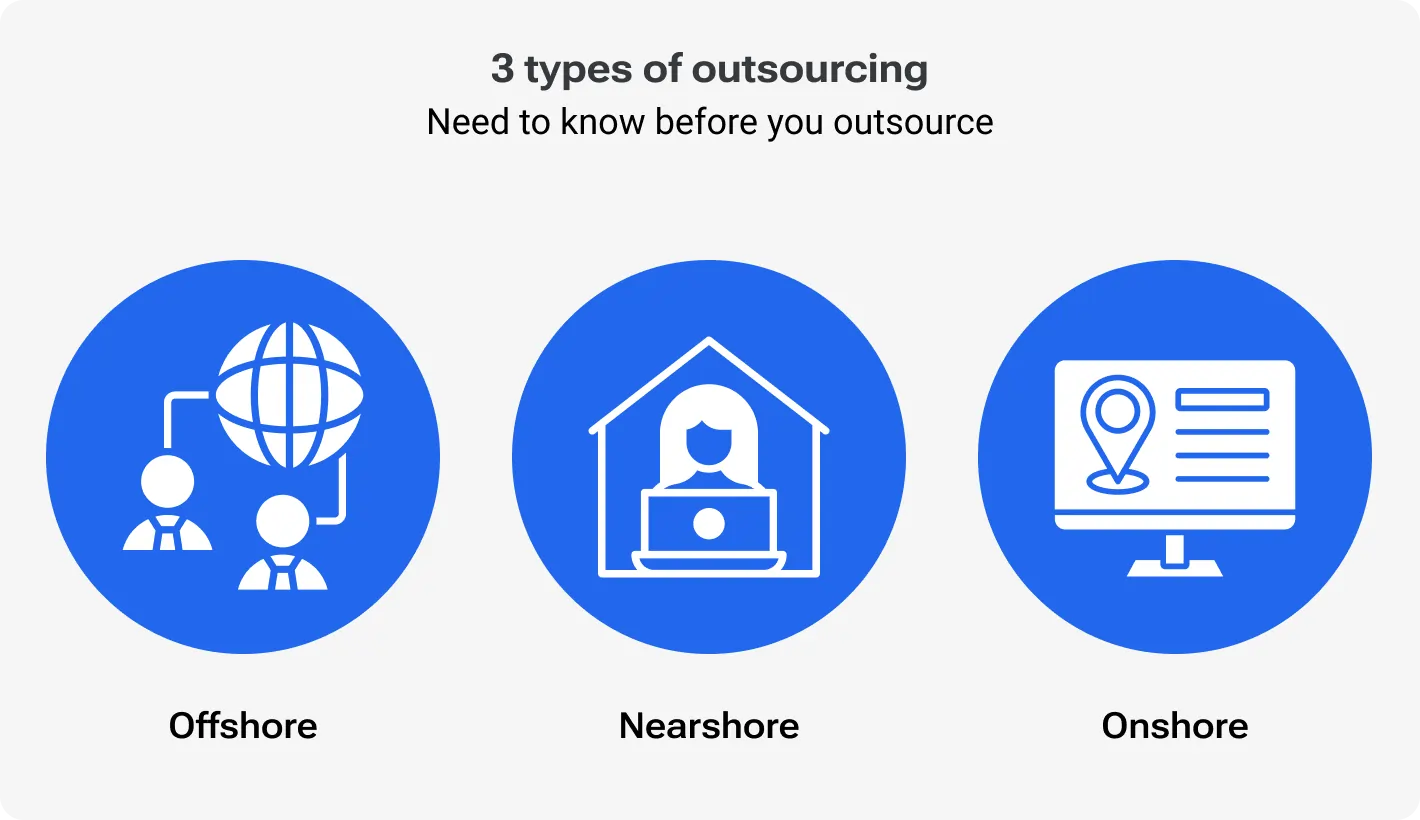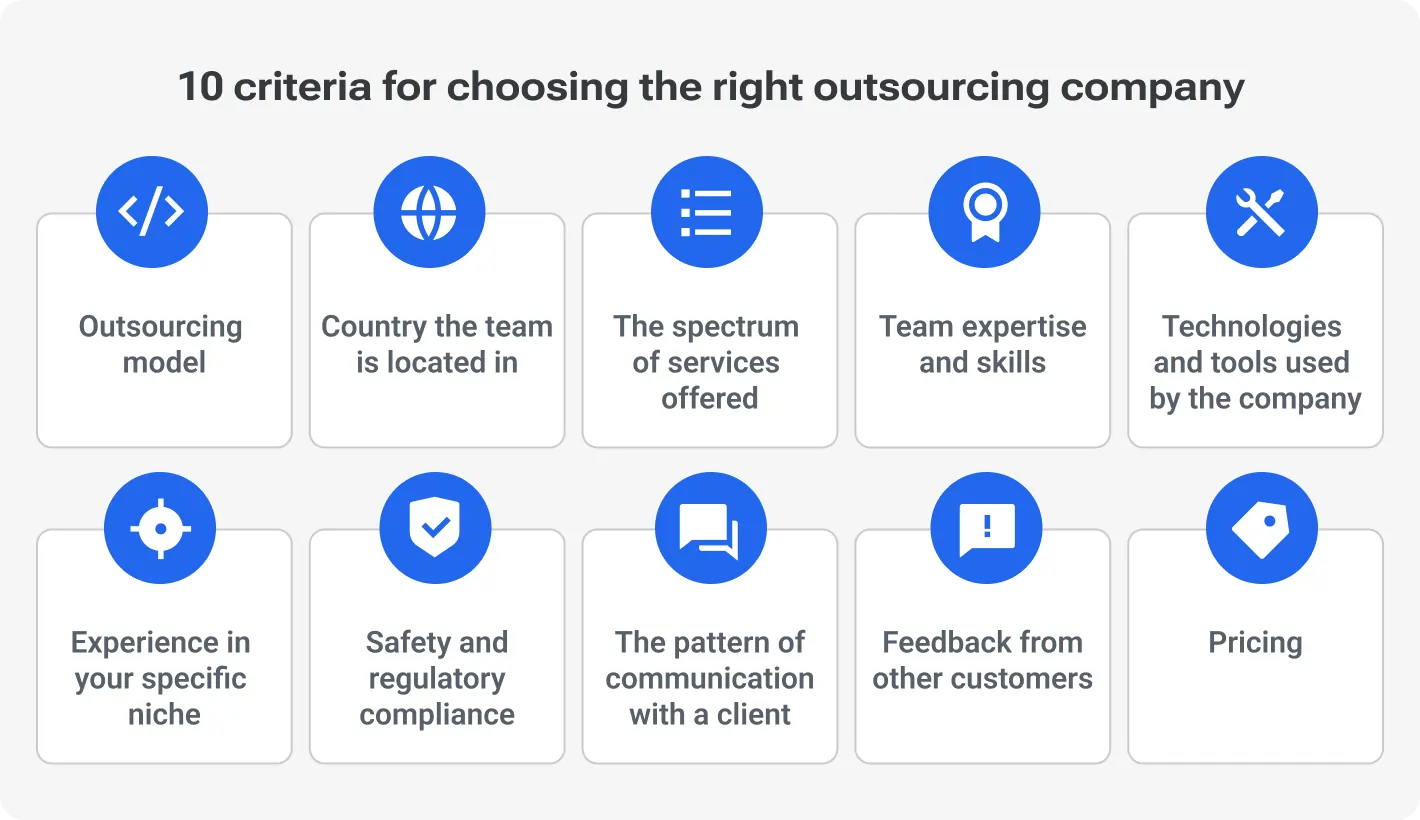Outsourcing to Czechia

How much does it cost to hire developers in Czechia?
Dec 2nd 25 - by Devico Team
Find out how much it costs to hire software developers in Czechia in 2025. Compare hourly rates, roles, and factors that impact pricing.
Hire
Hire by role
Hire Front-end developers
Hire Back-end developers
Hire Full-stack developers
Hire Android developers
Hire iOS developers
Hire Mobile developers
Hire AI engineers
Hire ML engineers
Hire Automation QA engineers
Hire Blockchain developers
Hire Data engineers
Hire Cloud engineers
Hire by skill
Hire JavaScript developers
Hire TypeScript developers
Hire Ruby on Rails developers
Hire React Native developers
Hire Flutter developers
Hire Golang developers
Hire React.js developers
Hire Python developers
Hire PHP developers
Hire .NET developers
Hire Java developers
Hire Laravel developers

Outsourcing
November 05, 2024 - by Devico Team
Summarize with:
Would you like your business to grow faster? However, your in-house development team may not be able to keep up with your ideas and ambitions. How to find a way out of this situation? From this article, learn what challenges in-house development is associated with and what alternatives to in-house development are available.
Setting up and retaining an internal team of engineers may be related to several difficulties that complicate and slow down company growth and development. Below, we will take a look at the most widespread ones.
Building and maintaining an in-house development team is quite an expensive endeavor. You have to set aside a sizeable budget for:
talent acquisition;
new employee hiring and adaptation;
payment of stable salaries to engineers regardless of their workload;
payment of vacation and sick leave;
health insurance costs;
provision of benefits, such as compensation for gym, psychologist, etc;
staff tuition;
payment of subscriptions to different tools and software required for work;
amortization of devices used by employees for work.
Finding good developers with the right skills for all your tasks can be daunting, especially if you are not considering a remote format and are therefore geographically limited. It would seem that there are plenty of software engineers in the world, and hiring one is not a problem. Yes, there are 28.7 million developers in the world at the moment. However, it is not easy to find the right fit even among such a huge variety. The following factors influence the search and hiring processes.
Since IT is a rather promising and rapidly developing field, there are many novice specialists on the market today: with minimal experience, as well as university graduates with no commercial experience at all. Such specialists are usually in a very active search, so there may be so many applications from them that you may even lose the applications of really valuable candidates among them.
There are many top professionals in the world. However, the demand for IT professionals is also frantic, and it keeps on growing. Therefore, engineers with solid experience and strong skills are usually already engaged in full-time jobs or several freelance projects. So, to interest top professionals in their vacancies, companies often need to offer above-market salaries or a huge variety of all kinds of bonuses that are not available in other organizations.
In the case of the office work format, not only the country/state/city where the job is offered, but even the neighborhood can be important. Many developers aren't willing to commute hours to work, so you may have to choose from those who live in a suitable location.
If you want to hire a highly skilled developer who, however, doesn't live in your area, and maybe not even in your city/state, you'll likely have to consider offering additional bonuses or an above-market salary to motivate the employee to relocate.
Despite high prospects and excellent working conditions in IT, this industry still has a high turnover rate of, on average, 13.2%. According to Zippia, 24% of developers quit their jobs even before their first anniversary at the company.
And if we take into account the statistics given above in the article, according to which employees reach their maximum productivity only after 8 months of work, with such a low tenure, some engineers leave without having shown their best performance at all or having just started to do so.
By maintaining an in-house development team, the company should take all of this into account when building its HR strategy. The first solution is constantly searching for and onboarding new team members, which requires budget and time. The second option is to take steps to retain employees. This can be done by offering some perks, bonuses, and rewards for good results, maintaining a healthy atmosphere and comfortable communication in the company, and otherwise taking care of the well-being of your employees.
It is vital to constantly grow and evolve to keep up with the competition. Scaling a business is a natural stage of growth. However, the internal team may not be able to keep up with the growing number of tasks.
Therefore, you will inevitably have to constantly look for new employees. And this is associated with additional budget and time spending. Usually, it takes 8 months for new team members to start working with 100% productivity.
There can be a significant staff problem if the company has too many diverse tasks that can be solved using different technologies. Or if the company's strategy and the appropriate technology stack for it change frequently (which is very relevant for startups that are still searching for their perfect development path).
In such a case, it is very difficult to find developers who master all the necessary technologies at once. Or you will have to spend considerable time and money on training/retraining your employees.
Sometimes even the most typical problems can be solved more effectively in innovative ways. And those developers who have been working on the same code for a long time may lose freshness of vision. They may lack new ideas and have difficulty with certain tasks, such as identifying and fixing bugs.
The constant introduction of innovations is the basis for the company's development. Without it, a business can fall behind the market realities and become uncompetitive.
However, an established team usually has a certain stable set of skills and technologies. Implementation of innovations may provoke cultural resistance on their part. To avoid this, an atmosphere of continuous learning and development must be established and maintained in the organization. This requires additional budget and time for constant employee training.
Technical team management often requires a lot of organization. Bureaucracy can be quite time-consuming, resulting in longer lead times for technical tasks.
In addition, if your internal team is not only developing but also maintaining your products, their productivity can drop significantly. There appear more and more support tasks over time. And, consequently, too few working hours left to develop something new, improve, and innovate. This can significantly slow down business growth.

A great way to overcome the challenges discussed above is to seek the services of an outsourced IT company. Many organizations completely outsource the development process. Meanwhile, some others use a hybrid development model: they have an in-house team and cooperate with partners, assigning them some part of the work, for example, code maintenance or solving some non-standard tasks.
Both of these options have many advantages over in-house development alone. Here are a few reasons to seek help or outsource the work entirely to an experienced and trustworthy IT company.
One of the most crucial outsourcing benefits is a great opportunity to save money. When you turn to external specialists, you only pay for the amount of work done. A partner company takes over all costs for setting up and maintaining the team, organizing the workflow, etc. This way, you only pay for the result, not the entire process.
Outsourcing companies usually have a remote team consisting of the best and most experienced employees from all around the world. When you turn to them, you are no longer limited to the expertise of only local developers. You can access the experience and skills of the most highly skilled professionals globally to solve your business tasks in the most effective way.
By ordering the services of an external team, you can bring your business ideas to life promptly. You get access to the experience and skills of top developers right away. You don't waste a minute of your time on talent acquisition, employee retention, organizing workflow and communication within the team, and so on. Outsourcing companies usually already have a team of developers with a wide range of skills for solving different tasks, and all processes are already well established.
Outsourcing companies anticipate the possibility of a wide variety of requests from their customers. Therefore, they have specialists with different expertise and skills. This allows them to adapt to your needs quickly and effectively.
Even if your conditions and requests change during the cooperation, for a good outsourcing IT company this will not be a big problem, since they always have a reserve of employees for urgent or changing tasks. This gives you the ability to quickly and effectively adapt to changing market conditions by adjusting your software development strategy at any stage.
When working with a partner company, you can constantly adjust and change the volume of ordered services by yourself if necessary. To increase the volume of work, you do not need to search, hire, and adapt new employees. You can scale your development process faster and more efficiently by simply ordering a larger volume of services. This contributes to more rapid business growth.
The introduction of cutting-edge technologies and innovative methods of solving problems is the key to the success of any modern organization. The use of AI, ML, cloud technologies, and other methods of automation and improvement of products and workflow contributes to swifter development and helps to bypass competitors in the tough struggle in the conditions of the modern market.
Good outsourced IT companies usually have a full range of such tools and employees with high expertise in using them. Good external IT companies usually have a full range of such tools and employees with high expertise in their use. This allows them to successfully implement the latest technologies for the benefit of the client's business.
Both outsourcing the work completely and cooperating with a partner company in addition to maintaining an in-house team can increase the efficiency and productivity of work. Here are some examples of how this is achieved:
Ultimate skills and expertise. Outsourcing companies often work with extremely highly qualified developers. Their many years of experience allow them to complete tasks as quickly as possible.
Utilizing the latest technologies. Good outsourced IT companies use modern tools to automate and optimize processes. This allows them to complete your tasks faster and cheaper.
Doing routine tasks. If you have your own internal development team, you can significantly increase its productivity by getting help from external specialists. You can outsource routine tasks, such as code support, thereby freeing up space for your full-time employees for more important strategic tasks.
Finding and implementing non-standard solutions. Some tasks may be too complex for your in-house professionals. In addition, you may sometimes need solutions to some highly specialized tasks. Naturally, hiring a permanent employee with the appropriate qualifications to perform a one-time or episodic task is not rational. In this case, you can contact an external company that will select an appropriate specialist from its talent pool. This way, you will get a quick solution to your problem at a reasonable price. Also, consultation with external specialists can help improve and refine the code by looking at it with a fresh eye.

To achieve a more productive and optimal development workflow, you first need to evaluate how your processes are organized now. You need to understand what strengths and weaknesses you have and how you can correct the flaws. Further from this article, you will learn how to assess the productivity of your development processes, identify deficiencies, and what options for improvement exist.
To determine whether your work processes are efficient and productive enough, use specific metrics. You can find the description of them in the table below.
Development velocity
This is the average amount of work completed during a sprint (iteration). It is usually measured in story points.
The arithmetic mean of the number of story points completed during several previous sprints.
Lead time
This is the total time it took to deliver the project: from the idea and task setting to the final result in the form of a product release.
Days from initiation to release.
Lead time for changes
This metric reflects the flexibility of the code and development strategy. It is the time that passes from the decision to make edits/changes/updates to their full implementation.
Hours/days that it takes from the decision to make edits to their full implementation.
Recovery time
This is the average time needed to make a code function correctly again after failure.
Hours from detecting a fall until restoring functionality completely.
Cycle time
This is the time it takes for each individual development cycle, such as writing code, deploying and delivering it, identifying bugs, bug fixing, etc.
Hours/days the certain cycle took.
Defect rate
This metric reflects the quality of code writing.
Defective lines of code / total number of lines * 100%
In addition to measuring productivity with metrics, it is also important to assess whether resources (such as budget, human resources, time, equipment, and so on) are properly allocated within the company (distributed between different projects, work stages, etc.). This can help you understand whether you are distributing all resources properly and how you can optimize their usage.
When you've already measured productivity and analyzed resource allocation, it's time to identify and document weaknesses. This is necessary for further creating the strategy for improvement.
To understand how you can upgrade your workflow, you need to detect two types of deficiencies: in the skills of your employees and in the organization of your work processes. How to do this? Find out further from this article.
Lack of required skills can lead to too long task completion, a higher number of bugs in products, insufficient quality of written code, quick burnout of employees due to facing too many complexities while doing tasks, and other problems.
You can uncover skill deficiencies easily in only three steps:
Determine what your business goals and development tasks are and make a list of the skills needed to accomplish them.
Identify and make a list of the competencies your engineers currently have.
Compare these two lists.
If you have found deficiencies, you should think about additional employee training or turning to outsourcing specialists to help with tasks that your in-house staff can't handle.
Flaws in the process organization can lead to numerous problems, such as:
delays;
increased budget for tasks;
incorrect task completion.
Here are the five most common workflow defects:
Slow decision-making.
Improper communication: lack of opportunity to discuss tasks, conflicts, poor feedback, etc.
No access to information needed to perform tasks.
Using legacy technology stack.
Lack of routine task automation.
How to identify the inefficiencies of this type in three steps:
Identify problems and shortcomings that often arise during the development process.
Make up a detailed roadmap of your workflow.
Find regularities between problems and workflow peculiarities.
The two best solutions for addressing skill deficiencies and process defects are transitioning to a fully outsourced or hybrid model. Let’s look at them in more detail.
Outsourcing is divided into three types, depending on the location of the partner company:
Offshore: a partner company is based in another country (usually quite far from the client).
Nearshore: an outsourcing team is located in another country, but the neighboring one.
Onshore: a partner company is from the same country that the client organization is.

From the table below, you can learn more about the benefits and drawbacks of each option.
Offshore
Greater variety of specialists, their expertise, and skills.
Budget savings.
Faster delivery of work
A risk of a cultural barrier.
Onshore
Time zone coincidence.
The absence of a language or cultural barrier.
High pricing.
Fewer skills diversity due to location restraints.
Nearshore
No time zone difference.
Greater variety of talent.
Language and cultural barriers.
The price of services may be quite high.
Which type offers the best price-to-performance ratio? The verdict – offshore. This type of outsourcing is a great choice for those who want to get high-quality services at a reasonable price.
This option allows you to get the pros of two models at the same time: in-house and outsourced development. This format of workflow provides for maintaining your own internal team and outsourcing some tasks at the same time.
You will have stability and permanence of your internal team. And cooperation with a partner company will allow you to:
Speed up the work. Buying the extra working hours of skilled external specialists will allow you to accelerate achieving your business goals.
Get new fresh ideas. External professionals can look at the code from a different angle and offer solutions that your internal employees, who are used to acting according to the patterns established in your company, might not have thought of.
Save the cost of hiring and maintaining additional employees. You can order an additional amount of work from an outsourcing team without spending a budget on finding new employees, paying stable salaries and bonuses to them, and so on.
Prevent burnout of in-house employees. You can outsource routine tasks, such as code maintenance. And your internal employees will be left with more creative and important tasks. This will keep them from getting bored and reduce the risk of burnout and high turnover.
To successfully transition to a new work pattern, you need to act consistently and systematically. Here are step-by-step instructions on how to do this.
Set goals for what exactly you want to achieve by switching to an alternative work model. Formulate them in terms of the metrics you are aiming for. Your objectives should be clear, time-bound, measurable, and achievable. If you're going to completely abandon the in-house team, assess all the risks involved, such as communication issues, lack of control, or security gaps.
Beyond the contract: Building strong relationships with your outsourcing partner
This is the most important step, as it will completely determine the outcome. It is crucial to thoroughly evaluate the company you are going to partner with. Consider the following criteria while choosing:
Outsourcing model.
Country the team is located in.
The spectrum of services offered.
Team expertise and skills.
Technologies and tools used by the company.
Experience in your specific niche (e.g., if you are a fintech business choose the company that has successful cases of cooperating specifically with fintech organizations).
Safety and regulatory compliance.
The pattern of communication with a client.
Feedback from other customers.
Pricing.

When transitioning, it is important to proceed smoothly to avoid unforeseen results. You can start by ordering a small amount of services. After evaluating the results and your experience with the company, you will be able to entrust it with more and more tasks. A smooth transition to the new model is possible in several phases:
The transfer of knowledge.
Making a map of the processes.
Transitioning the technology and infrastructure.
Testing.
Managing change.
The last phase may be the most challenging. Moving to a new work model can entail cultural resistance and other unexpected issues. To manage them, prepare employees and stakeholders for this well in advance, as well as ensure comfortable, effective, and smooth communication and feedback during the transition.
Regularly request progress reports from the outsourced team, and measure metrics that reflect development efficiency and productivity described earlier in the article. By doing so, you will be able to make sure you are getting quality services. Even if some issues do arise, you will be able to identify and resolve them early on thanks to quality organized feedback. Additionally, this will allow you to adjust and improve your development strategy over time.
How to manage an outsourced development team effectively
Devico has been providing high-quality IT services since 2010. For years of work, we have helped dozens of businesses improve their processes and achieve their goals. Below, you will find some real cases and feedback from our clients.
Devico has extensive experience cooperating with companies that operate in a wide variety of niches, including healthcare, fintech, cybersecurity, retail, and many others. Here are some examples of successful collaboration with clients.
Moneygate, a company that provides a digital payment solution, has decided to hire a full-value team of outsourced specialists to develop a mobile app. 2 React-Native developers, 1 QA engineer, 1 designer, and 1 business analyst from Devico provided the client with a full cycle of services: from creating the clear and detailed functional requirements and making the design to turnkey application development and quality assurance.
The consistent and quality work of outsourcing specialists allowed the company to present to its clients a convenient and secure application with numerous functions for financial management and transactions.
GoodShape, a company that provides a platform for monitoring employee health and well-being, faced troubles while improving and scaling. Legacy technologies and inflexible architecture hindered adding new features and prevented the business from growing.
The best solution was to hire highly qualified dedicated outsourced professionals. Devico’s experienced specialists have done a great deal of work:
performed a thorough code audit;
refactored and standardized it;
found and fixed numerous bugs;
revised the technology stack and moved to newer and more flexible options;
helped the company to optimize its workflow by automatizing some processes, such as reporting; improved UI/UX;
added new features to the app.
All of this has allowed the company to improve customer satisfaction, attract more clients, and become even more successful. Users of its app include major companies, such as Philips and the NHS.
In-house development is a classic and stable option. However, it also has its downsides. The most common difficulties associated with this model of work are:
talent acquisition challenges;
limited pool of talent and skills;
the need to deal with turnover;
insufficient scalability;
reduced flexibility;
lack of new ideas;
stagnation in terms of technology;
operational difficulties and shortcomings.
Partial or full outsourcing can help solve all of these problems. Cooperating with a partner IT company has multiple benefits, including:
speeding up the workflow;
enhancing flexibility;
boosting scalability;
getting more opportunities for business innovation;
Contact us and let experienced external IT professionals transition you to a new work model for all benefits to enjoy and forget about the workflow gaps you have now.
Outsourcing to Czechia

Dec 2nd 25 - by Devico Team
Find out how much it costs to hire software developers in Czechia in 2025. Compare hourly rates, roles, and factors that impact pricing.
Outsourcing to Czechia

Nov 25th 25 - by Devico Team
Compare Czechia and Poland for software outsourcing in 2025. Discover costs, talent, infrastructure, and which country fits your project best.
Outsourcing to Czechia

Nov 18th 25 - by Devico Team
A complete guide to outsourcing software projects to Czechia, learn about costs, talent, benefits, and how to build successful partnerships in 2025.